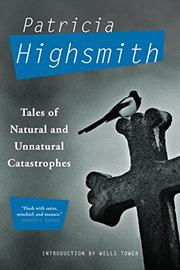

TALES OF NATURAL AND UNNATURAL CATASTROPHES
by Patricia Highsmith
Ten heavy-handed parables, mostly cartoonish and occasionally stomach-turning—aimed at such worthy but obvious contemporary targets as homelessness, pollution, militarism, nuclear power, right-wing religions, and Nancy Reagan. None of these preachy farces is thought-provoking or genuinely horrific, but a few do conjure up images that are undeniably nauseating. In "The Mysterious Cemetery," cavalier medical research on cancer leads to an outbreak of huge earth-tumors in the neighborhood. "Nabuti: Warm Welcome to a UN Committee" is a sickening sketch—dead bodies festering in jammed elevators—of what can happen when an African land is given independence and modern technology. . .and then left to stew in ignorance, greed, and brutality. And "Trouble at the Jade Towers" offers a posh Manhattan hi-rise besieged by relentless, ever-larger cockroaches. Elsewhere, however, Highsmith's stories lack such vividly revolting specifics—and are merely transparent and dull. Whale-hunters get their just deserts when their quarry latches onto some modern human weaponry ("Moby Dick II; or The Missile Whale"). The government tries to dispose of nuclear waste in new, secret underground vaults—with predictably disastrous results. The homeless masses—mostly de-institutionalized mental patients—converge on the White House lawn. A new Pope starts a global revolution by suddenly announcing that abortion and birth control (among other things) are okay. And, in the book's overlong final entry, a Reagan-like President is bedeviled by an arms-for-hostages scandal—until his Scotch-swilling First Lady simplifies things by pushing the button that begins nuclear war with Russia. As political satire, then, these scenarios lack both imagination and depth—not to mention laughs. (An average Saturday Night Live skit is both funnier and subtler.) As futuristic horror, one or two of them are only slightly more successful. Together with the shaky novel Found in the Street and other recent story collections, these crude tales suggest that Highsmith—once such a powerful storyteller—is no longer in full artistic control of her morbidity and misanthropy.